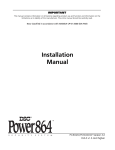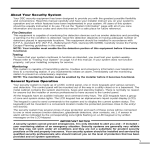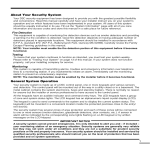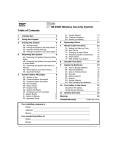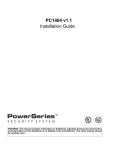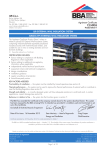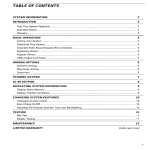Download PC5008 v2-5U UK um en 29005122 r001.p65
Transcript
• W A R N I N G • This manual contains information on limitations regarding product use and function and information on the limitations as to liability of the manufacturer. The entire manual should be carefully read. Instruction Manual Software Version 2.5U WARNING Please Read Carefully Note to Installers This warning contains vital information. As the only individual in contact with system users, it is your responsibility to bring each item in this warning to the attention of the users of this system. System Failures This system has been carefully designed to be as effective as possible. There are circumstances, however, involving fire, burglary, or other types of emergencies where it may not provide protection. Any alarm system of any type may be compromised deliberately or may fail to operate as expected for a variety of reasons. Some but not all of these reasons may be: ■ Inadequate Installation A security system must be installed properly in order to provide adequate protection. Every installation should be evaluated by a security professional to ensure that all access points and areas are covered. Locks and latches on windows and doors must be secure and operate as intended. Windows, doors, walls, ceilings and other building materials must be of sufficient strength and construction to provide the level of protection expected. A reevaluation must be done during and after any construction activity. An evaluation by the fire and/ or police department is highly recommended if this service is available. ■ Criminal Knowledge This system contains security features which were known to be effective at the time of manufacture. It is possible for persons with criminal intent to develop techniques which reduce the effectiveness of these features. It is important that a security system be reviewed periodically to ensure that its features remain effective and that it be updated or replaced if it is found that it does not provide the protection expected. ■ Access by Intruders Intruders may enter through an unprotected access point, circumvent a sensing device, evade detection by moving through an area of insufficient coverage, disconnect a warning device, or interfere with or prevent the proper operation of the system. ■ Power Failure Control units, intrusion detectors, smoke detectors and many other security devices require an adequate power supply for proper operation. If a device operates from batteries, it is possible for the batteries to fail. Even if the batteries have not failed, they must be charged, in good condition and installed correctly. If a device operates only by AC power, any interruption, however brief, will render that device inoperative while it does not have power. Power interruptions of any length are often accompanied by voltage fluctuations which may damage electronic equipment such as a security system. After a power interruption has occurred, immediately conduct a complete system test to ensure that the system operates as intended. ■ Failure of Replaceable Batteries This system’s wireless transmitters have been designed to provide several years of battery life under normal conditions. The expected battery life is a function of the device environment, usage and type. Ambient conditions such as high humidity, high or low temperatures, or large temperature fluctuations may reduce the expected battery life. While each transmitting device has a low battery monitor which identifies when the batteries need to be replaced, this monitor may fail to operate as expected. Regular testing and maintenance will keep the system in good operating condition. ■ Compromise of Radio Frequency (Wireless) Devices Signals may not reach the receiver under all circumstances which could include metal objects placed on or near the radio path or deliberate jamming or other inadvertent radio signal interference. ■ System Users A user may not be able to operate a panic or emergency switch possibly due to permanent or temporary physical disability, inability to reach the device in time, or unfamiliarity with the correct operation. It is important that all system users be trained in the correct operation of the alarm system and that they know how to respond when the system indicates an alarm. ■ Smoke Detectors Smoke detectors that are a part of this system may not properly alert occupants of a fire for a number of reasons, some of which follow. The smoke detectors may have been improperly installed or positioned. Smoke may not be able to reach the smoke detectors, such as when the fire is in a chimney, walls or roofs, or on the other side of closed doors. Smoke detectors may not detect smoke from fires on another level of the residence or building. Every fire is different in the amount of smoke produced and the rate of burning. Smoke detectors cannot sense all types of fires equally well. Smoke detectors may not provide timely warning of fires caused by carelessness or safety hazards such as smoking in bed, violent explosions, escaping gas, improper storage of flammable materials, overloaded electrical circuits, children playing with matches or arson. Even if the smoke detector operates as intended, there may be circumstances when there is insufficient warning to allow all occupants to escape in time to avoid injury or death. ■ Motion Detectors Motion detectors can only detect motion within the designated areas as shown in their respective installation instructions. They cannot discriminate between intruders and intended occupants. Motion detectors do not provide volumetric area protection. They have multiple beams of detection and motion can only be detected in unobstructed areas covered by these beams. They cannot detect motion which occurs behind walls, ceilings, floor, closed doors, glass partitions, glass doors or windows. Any type of tampering whether intentional or unintentional such as masking, painting, or spraying of any material on the lenses, mirrors, windows or any other part of the detection system will impair its proper operation. Passive infrared motion detectors operate by sensing changes in temperature. However their effectiveness can be reduced when the ambient temperature rises near or above body temperature or if there are intentional or unintentional sources of heat in or near the detection area. Some of these heat sources could be heaters, radiators, stoves, barbeques, fireplaces, sunlight, steam vents, lighting and so on. ■ Warning Devices Warning devices such as sirens, bells, horns, or strobes may not warn people or waken someone sleeping if there is an intervening wall or door. If warning devices are located on a different level of the residence or premise, then it is less likely that the occupants will be alerted or awakened. Audible warning devices may be interfered with by other noise sources such as stereos, radios, televisions, air conditioners or other appliances, or passing traffic. Audible warning devices, however loud, may not be heard by a hearing-impaired person. ■ Telephone Lines If telephone lines are used to transmit alarms, they may be out of service or busy for certain periods of time. Also an intruder may cut the telephone line or defeat its operation by more sophisticated means which may be difficult to detect. ■ Insufficient Time There may be circumstances when the system will operate as intended, yet the occupants will not be protected from the emergency due to their inability to respond to the warnings in a timely manner. If the system is monitored, the response may not occur in time to protect the occupants or their belongings. ■ Component Failure Although every effort has been made to make this system as reliable as possible, the system may fail to function as intended due to the failure of a component. ■ Inadequate Testing Most problems that would prevent an alarm system from operating as intended can be found by regular testing and maintenance. The complete system should be tested weekly and immediately after a break-in, an attempted break-in, a fire, a storm, an earthquake, an accident, or any kind of construction activity inside or outside the premises. The testing should include all sensing devices, keypads, consoles, alarm indicating devices and any other operational devices that are part of the system. ■ Security and Insurance Regardless of its capabilities, an alarm system is not a substitute for property or life insurance. An alarm system also is not a substitute for property owners, renters, or other occupants to act prudently to prevent or minimize the harmful effects of an emergency situation. About Your Security System Your DSC security equipment has been designed to provide you with the greatest possible flexibility and convenience. Read this manual carefully and have your installer instruct you on your system's operation and on which features have been implemented in your system. All users of this system should be equally instructed in its use. Fill out the “System Information” page with all of your zone information and access codes and store this manual in a safe place for future reference. Fire Detection This equipment is capable of monitoring fire detection devices such as smoke detectors and providing a warning if a fire condition is detected. Good fire detection depends on having adequate number of detectors placed in appropriate locations. This equipment should be installed in accordance with your local fire laws and recommendations. Carefully review the Family Escape Planning guidelines in this manual. NOTE: Your installer must enable the fire detection portion of this equipment before it becomes functional. Testing To insure that your system continues to functions as intended, you must test your system weekly. Please refer to “Testing Your System” on page 12 of this manual. If your system does not function properly, call your installing company for service. Monitoring This system is capable of transmitting alarms, troubles and emergency information over telephone lines to a monitoring station. NOTE: The monitoring function must be enabled by the installer before it becomes functional. General System Operation Your security system is made up of a DSC control panel, one or more keypads and various sensors and detectors. The control panel will be mounted out of the way in a utility closet or in a basement. The metal cabinet contains the system electronics, fuses and stand-by battery. There is no reason for anyone but the installer or service professional to have access to the control panel. All the keypads have an audible indicator and command entry keys. The LED keypads have a group of zone and system status lights. The LCD keypad has an alphanumeric liquid crystal display (LCD). The keypad is used to send commands to the system and to display the current system status. The keypad(s) will be mounted in a convenient location inside the protected premises close to the entry/exit door(s). The security system has several zones of area protection and each of these zones will be connected to one or more sensors (motion detectors, glassbreak detectors, door contacts, etc.). A sensor in alarm will be indicated by the corresponding zone lights flashing on a LED keypad or by written messages on the LCD keypad. IMPORTANT NOTICE A security system cannot prevent emergencies. It is only intended to alert you and – if included – your monitoring station of an emergency situation. Security systems are generally very reliable but they may not work under all conditions and they are not a substitute for prudent security practices or life and property insurance. Your security system should be installed and serviced by qualified security professionals who should instruct you on the level of protection that has been provided and on system operations. 1 System Information Fill out the following information for future reference and store this manual in a safe place. Access Codes Your Master Code is: __________________________________________ Additional Access Codes: 01 __________________ 09 ____________________ 17 ____________________ 25 ________________ 02 __________________ 10 ____________________ 18 ____________________ 26 ________________ 03 __________________ 11 ____________________ 19 ____________________ 27 ________________ 04 __________________ 12 ____________________ 20 ____________________ 28 ________________ 05 __________________ 13 ____________________ 21 ____________________ 29 ________________ 06 __________________ 14 ____________________ 22 ____________________ 30 ________________ 07 __________________ 15 ____________________ 23 ____________________ 31 ________________ 08 __________________ 16 ____________________ 24 ____________________ 32 ________________ Zone Information There are ________ active zones on the system. Zone Protected Area Zone Type 1 ___________________________________________ _____________________________________ 2 ___________________________________________ _____________________________________ 3 ___________________________________________ _____________________________________ 4 ___________________________________________ _____________________________________ 5 ___________________________________________ _____________________________________ 6 ___________________________________________ _____________________________________ 7 ___________________________________________ _____________________________________ 8 ___________________________________________ _____________________________________ [F] FIRE __________________________________________ [A] AUXILIARY ____________________________________ [P] PANIC ________________________________________ The Exit Delay Time is ________ seconds. The Entry Delay Time is _______ seconds. For Service 2 Central Station Information: Account #: ___________________________________ Telephone #: _________________________________ Installer Information: Company: ___________________________________ Telephone #: _________________________________ Access Codes Access codes are used to arm and disarm the system. There are 37 access codes available: 1 master code, 32 regular access codes, 2 duress codes and 2 supervision codes. Ask your installer for more information on using the duress and supervision codes. Only the Master Code can be used to program additional security codes and to change other system features as well as to arm and disarm the security system. The Master Code will be supplied to you by your installer. All keypad entries are made by pressing one key at a time. All access codes can be programmed by following the procedure outlined in “Programming Security Codes” on page 6. NOTE: An access code can be a four or six digit number depending on how your installer has programmed your system. Ask your installer for more information regarding access codes. Arming the System Arming Procedure: In an attempt to reduce false alarms, your system is designed to notify you of an improper exit when arming the system. With the Push to Set or the Final Door Set, if you enter your code to arm the system your panel will start an infinite exit delay. The keypad will sound a beep once ever second. If you violate a zone while exiting the premise the keypad will sound 6 quick beeps when you walk past a motion detector or open a window or door with a magnetic contact on it. When you have opened and closed the Final Exit door or after closing the final exit door have pressed the Push to Set button, the keypad will continue to beep once every second for 5 seconds. The panel uses these 5 seconds to allow time for the detectors on the system to settle back to their normal states. At the end of this settling time the system checks for detectors/windows/doors that may be open. If any of these are open the panel will sound a tone and arming will be canceled. If this occurs, you must re-enter the premises, check the system, close any open zones, and the follow the arming procedure again. Arming from an LED Keypad: If the Ready light is ON, the system is ready for arming. If the Ready light is OFF, check to see that all doors and windows are closed and that motion is stopped in areas covered by motion detectors. The system cannot be armed unless the Ready light is ON indicating that all zones are closed and the system is in the Ready state. Enter your access code. As each digit is entered, the keypad sounder will beep. If the access code was entered incorrectly, the keypad buzzer will sound steadily for one second. If this occurs, press the [#] key and re-enter your access code. If the correct access code is entered, the keypad sounder will beep quickly and the Armed light will come ON. Exit the premises through the door indicated by your installer as the Exit/Entry door. The panel will provide an exit delay period, indicated by keypad beeps, for you to exit the premises without causing an alarm. At the end of the exit delay period, all keypad lights, except the Armed light, will turn OFF and the system will be armed. You can restart the exit delay once by pressing the Away button before the exit delay expires. The exit delay time can be changed by your installer. Arming from an LCD Keypad: Secure System Before Arming <> Enter Code to Arm System <> If the Ready light is ON, the system is ready for arming. If the Ready light is OFF, this message will appear on the LCD display. Ensure all doors and windows are closed and motion is stopped in areas covered by motion detectors. The system cannot be armed unless the Ready light is ON indicating that all zones are closed and the system is in the Ready state. When this message appears, use the arrow (< >) keys to verify that the system is clear of troubles and that no zones are bypassed unintentionally (see “Viewing Trouble Conditions” on page 11, and “Zone Bypassing” on page 10). 3 Enter Code to Arm System Exit Delay in Progress If this display is showing, the system is in the Ready state and may be fully armed. To arm the system, enter your access code. Once the correct access code has been entered, the display will be as shown. The panel will provide an exit delay period, also indicated by keypad beeps, for you to exit the premises without causing an alarm. You can restart the exit delay once by pressing the Away button before the exit delay expires. Exit through the door indicated by your installer as the Exit/Entry door. Enter Code to Disarm System This message will be displayed once the exit delay expires and the system is fully armed. * WARNING * Bypass Active If this message appears, be aware of which zones are bypassed and why (see “Zone Bypassing” on page 10). NOTE: If you arm the system with a zone bypassed or with a trouble present, your security protection is reduced. Alternate Arming Methods Away Arming Arming the system in the Away mode will have all interior zones and perimeter zones active. If motion is detected in the interior zones, or if one of the perimeter zones is violated, the alarm sequence will begin. To arm in the Away mode, enter your access code and exit the premises through a designated Exit/Entry door. The system will recognise that occupants have left the premises. Once the exit delay expires, the system will be fully armed. You can restart the exit delay once by pressing the Away button before the exit delay expires. Stay Arming This feature, will allow you to arm the perimeter zones while leaving the interior zones inactive so that you can remain on the premises while the system is armed. When you press the Stay Key and then enter your security code to arm the system, it will arm in the Stay mode, automatically bypassing the interior zones. The interior zones can be reactivated at any time by entering [✱][1] at any keypad. If you reactivate the interior zones, be sure to only inhabit areas not covered by motion detectors. To access areas protected by motion sensors, you must enter your security code and disarm the system. Quick Exit When the Quick Exit feature is enabled, pressing [✱][0] while the system is armed will provide a two minute window for you to exit the premises. During this time, you may only open and close the designated Entry/Exit door once. Once the door is closed, the panel will end the two minute quick exit delay. If the door is opened again, or if the door is not closed after two minutes, or if another zone is opened, the panel will begin the entry delay. Your installer will inform you if the Quick Exit feature has been enabled on your system. 4 Disarming the System Disarming from an LED Keypad: Enter the premises through a designated Exit/Entry door; entering by any other door will sound an immediate alarm. As soon as the Exit/Entry door is opened, the keypad will beep to indicate that the system should be disarmed. Go to the keypad and enter your access code. If an error is made entering the code, enter your code again. As soon as the correct code is entered, the Armed light will go out and the keypad will stop beeping. The correct access code must be entered before the entry delay period expires. If a valid access code is not entered during this time, the system will go into alarm. The entry time delay may be changed by your installer. If an alarm occurred while the system was armed, the Memory light and the zone light corresponding to the zone which caused the alarm will flash for 30 seconds. After the 30 second period, the Memory light and zone light will stop flashing and the panel will return to the Ready state. Pressing the [#] key during the 30 second period will cancel the alarm memory display. To view other alarms, press [✱][3]. If a trouble was detected when the panel is disarmed, the Trouble light will turn ON (See “Viewing Trouble Conditions” on page 11 to determine the source of the trouble.) Please note that troubles will not display while the system is in the Alarm Memory Display mode. Disarming Procedure: Upon entering through a designated Exit/Entry door, the keypad will beep and the entry delay will commence, reminding you to disarm the system. The keypad will display the following message... Enter your access code. If an error is made in entering the code, press [#] to Entry Active Enter Your Code cancel and then re-enter the code again. When a valid access code is entered, the keypad will stop beeping. If no alarms occurred while the panel was armed, and there are no troubles, the display will read... System Disarmed No Alarm Memory After about five seconds, the system will return to the Ready state and the display will read... Enter Code to Arm System If an alarm occurred while the system was armed, this message will be displayed. Use View Memory <> “Zone of Alarm” the arrow (< >) keys to view which zones caused the alarm. If a zone is still in alarm, the display will show the following message to indicate that a zone is open... Secure System Before Arming <> Upon disarming and if a trouble is present, this message will be displayed. Use the Enter Code to Arm System <> arrow (< >) keys to view which troubles are affecting the system (see “Viewing Trouble Conditions” on page 11). NOTE: If you return and find that an alarm has occurred while you were away, it is possible that an intruder may still be on the premises. Take appropriate action. The alarm memory is cleared each time the panel is armed so that any alarms showing are alarms that occurred only during the last armed period. 5 If An Alarm Sounds Fire Alarm If your system has been installed with fire detectors and the alarm sounds in a pulsing mode, follow your emergency evacuation plan immediately (see “Fire Escape Planning” on page 15). Intrusion Alarm If an intrusion alarm sounds, indicated by a continuous Bell or Siren, the alarm may be silenced by entering your access code, if the alarm was unintentional. You can determine the source of the alarm by following the instructions in the “Disarming” section (see page 5). Once the source of the alarm has been corrected, the system will require a reset. NOTE: A fire alarm has priority over a burglary type alarm (all monitored systems). Resetting the system Your installer will let you know if your system is set up so that if there is an alarm, you will need to reset your system. This is done to ensure that after an alarm your system is working properly. There are two ways your system can be reset. Engineer’s Reset If an alarm has occurred on your system, the system will not allow you to rearm (Read light is OFF). You will need to contact you installer. They will check and reset the system for you. After the reset is preformed your system will function properly again. Remote Reset After you have silenced an alarm on your system, the keypad will display a message “Remote Reset Rqd” along with a 4-digit Lock Code. The display will pause for 3 seconds, and then repeat the lock code. If your system needs resetting you will not be able to perform any system function, except for viewing the alarm memory ([*][3]) or activating command outputs such as sensor reset ([*][7]). The rest of the system will function as normal (i.e. alarms and troubles will still be monitored). You will only be able to reset the system by entering a Reset Code. To get the reset code you will have to contact your installer or central station. Provide them with the 4-digit Lock Code number that is displayed on your keypad. Your installer or central station will in turn provide you with a new 4-digit Reset Code. Enter the Reset Code into the keypad. The keypad will reset and function system will return to normal. Function Keys The PC5508Z and LCD5500Z keypads have five function keys – marked Stay, Away, Chime, Reset and Exit – which allow easy single-button activation of the most commonly used features. If these keys have been enabled by your installer, you can execute the programmed function by pressing and holding the corresponding key for two seconds. For more information regarding the operation of the function keys, talk to your alarm system installer. Programming Security Codes Programming codes from an LED Keypad: The Master Code To program the Master Code, enter [✱][5][current Master Code][40][new Master Code]. The Master Code must be four digits unless otherwise indicated by your installer. Enter digits 0 through 9 only. Press [#] to return to the Ready state. Be sure to record your new Master Code on the “System Information” page in this booklet. NOTE: We recommend that the factory default or obvious codes such as [1111] or [1234] not be used. 6 Additional Codes Up to 32 additional access codes (01 through 32) may be programmed. To program a new code: Enter [✱][5][Master Code][code number 01 to 32][new access code]. The code number is a double digit from 01 to 32. Access codes must be four digits unless otherwise indicated by your installer. Enter digits 0 through 9 only. Press [#] to return to the Ready state. If an access code already exists for the code number you have selected, it will be replaced by the new code. Be sure to record your new code(s) on the “System Information” page in this book. To erase a code: Enter [✱][5][Master Code][code number 01 to 32][✱]. Press [#] to return to the Ready state. The Master code cannot be erased. Programming codes from an LCD Keypad: Master Code Press the [✱] key to enter the function list. Scroll (< >) to... Press (*) for <> Press [5] or [✱]. The display will read... Access Codes Enter Master Access Code Enter your current Master Code. The display will read... (*) to Edit <> “40P” represents the Master Code. Press the [✱] key to indicate that you wish to User Code 40P program the Master Code. The display will read... Enter the new Master Code. The Master Code must be four digits unless otherwise Enter New Code 1234 <> indicated by your installer. Enter digits 0 through 9 only. Once the new code is entered, the keypad will beep 3 times and the display will read... (*) to Edit <> Press [#] to exit the code programming function. User Code 40P Be sure to record your new Master Code on the “System Information” page in this booklet. NOTE: We recommend that the factory default Master Code [1234] not be used. Additional Access Codes To erase, add or change a user code, press [✱] to enter the functions list. Use the arrow (< >) keys to scroll to the following message... Press (*) for <> Press [✱]. Display will read... Access Codes Enter Master Access Code Enter the Master Code. Display will read... [*] to Edit <> Use the scroll keys (< >) to find the access code – indicated by “01P” to “32P” – you User Code 01P wish to add, change or delete. Press the [✱] key to select the code you wish to alter. The display will read... To add or change a code, enter the new code. Access codes must be four digits Enter New Code 1234 <> unless otherwise indicated by your installer. Enter digits 0 through 9 only. To delete an access code, enter [✱]. Once the 4 digit code or [✱] has been entered, the keypad sounder will beep 3 times and the display will read... [*] to Edit <> The “P” means the code has been programmed. If there is no “P” then that code is deleted. User Code 01P Press [#] to exit the code programming function. The Master code cannot be erased. Remember to record your new code(s) on the “System Information” page in this booklet. 7 PC5508Z LED Keypad Emergency Keys (All Keypads) PC5508Z, LCD5500Z: Press both * Keys for two seconds to send a FIRE transmission. Press both * Keys for two seconds to send an AUXILIARY transmission. Press both * Keys for two seconds to send a PANIC transmission. * IMPORTANT NOTE (All Keypads): The Fire, Auxiliary and Panic keys will NOT function unless programmed by the installer. If these keys are in service and the installer has enabled audible feedback, holding down the key for two seconds will cause the keypad sounder to beep indicating that the input has been accepted and transmission is underway. keys are NOTE: In the U.S.A. the [A] and programmed to be used for non-medical emergencies only, as per UL requirements. Display Lights (PC5508Z Keypad) Memory Light Upon disarming, if an alarm has occurred while the system was armed, the Memory light will turn ON (See “Disarming the System” on page 6). Bypass Light If the Bypass light is ON, one or more zones are bypassed (See “Zone Bypassing” on page 10). Fire Light If the Fire light is ON, a fire alarm has occurred (See “Fire Alarm Operation” on page 14). Program Light The Program light will flash when you are programming access codes, or performing other programming functions. If someone is programming at another keypad, the Program light will turn ON to indicate that the system is busy. 8 LCD5500Z Keypad The Liquid Crystal Display (LCD) displays prompts and system information on two 16 character lines. If “< >” appears, more information can be accessed by using the arrow (< >) keys. Press [<] to see the previous function or item of information. Press [>] to advance the display to next function or item of information. Press the keys on the number pad as prompted by the LCD display to view alarms or troubles, to arm and disarm the system and to bypass zones. To exit a function and return to the Ready state, press [#]. To select a function press [✱]. Display Lights (All Keypads) Ready Light If the Ready light is ON, the system is ready for arming. The system cannot be armed unless the Ready light is ON (see “Arming the System” on page 4). Armed Light If the Armed light is ON, the system has been armed successfully. Trouble or System Light If the Trouble light is ON, see “Viewing Trouble Conditions” on page 11. • Important Note • Test system weekly and have any system trouble conditions corrected by your alarm installer. 9 Zone Bypassing The zone bypassing function is used when access is needed to part of the protected area while the system is armed. Zones which are temporarily out of service due to damaged wiring or contacts may be bypassed to allow system arming until repairs can be made. Bypassed zones will not cause an alarm. Zones cannot be bypassed once the system is armed. Bypassed zones are automatically cancelled each time the system is disarmed and must be reapplied before the next arming. NOTE: For security reasons, your installer may program the system to prevent you from bypassing certain zones. Bypassing zones reduces your security protection. If you are bypassing a zone due to damaged wiring or contacts, please call a service technician immediately so that the problem can be resolved and your system returned to proper working order. Do not unintentionally bypass zones when you arm your system. To bypass zones from an LED keypad: Start with the system in the Ready state. Enter [✱][1][Zone number(s) to be bypassed]. Enter the zone number(s) as a double digit from 01 to 08. As each zone is bypassed, the corresponding zone light will turn ON. If a zone is bypassed by mistake, press that zone number again and the zone light will turn OFF, indicating that the zone is not bypassed. Press [#] to return to the Ready state. When the system is armed, the Bypass light will be ON if one or more zones are bypassed. To bypass zones from an LCD keypad: To bypass a zone, the system must be in the Ready state. The display will read... Press the [✱] key to enter the functions menu. The display will read... Enter Code to Arm System Press (*) for <> Press the [✱] key to enter the zone bypassing mode. The display will read... Zone Bypass Zone Search “Zone Name” <> Use the arrow (< >) keys to find the zone to be bypassed and press the [✱] key to select Zone Search “Zone Name” <> B Zone Search “Zone Name” <> O it. The display will read... “B” will appear on the display to show that the zone is bypassed. To unbypass a zone, enter the zone number; the “B” will disappear from the display to show that the zone is no longer bypassed. This display will be shown if a zone was open when you entered the bypassing command. The open zone will be represented by “O”. If you bypass the open zone, the “O” will be replaced by a “B”. To exit the bypassing mode and return to the Ready state, press the [#] key. Bypass Groups A Bypass Group is a selection of zones programmed into the system’s memory. The Bypass Group can be recalled upon arming to allow quick bypassing of a selection of zones on a regular basis. To program the Bypass Group, perform the following: 1. Press [✱][1], followed by your access code, if necessary. 2. Enter the zone numbers of the zones to be included in the Bypass Group. Each zone number is two digits. 3. Once all zones to be included have been selected, press [9][5]. To select the Bypass Group when arming the system, perform the following: 1. Press [✱][1], followed by your access code, if necessary. 2. Press [9][1]. 3. Press [#] to return to the Ready state. Arm the system. 10 Additional Zone Bypassing Features To recall the last set of bypassed zones, press [✱][1][9][9]. Arm the system. The Bypass light will turn on to indicate that zones are bypassed. To clear all bypassed zones, press [✱][1][0][0]. Viewing Trouble Conditions The control panel continuously monitors a number of possible trouble conditions. If one of these trouble conditions occur, the keypad will beep twice every 10 seconds until you press any key on the keypad. NOTE: A TROUBLE condition reduces the security your system is designed to provide. Call your installing company for service. To view troubles from an LED Keypad: A trouble will be indicated by the Trouble light (or System light on a PC1555RKZ keypad) which will remain ON until the trouble condition is cleared. If you cannot determine the cause of the trouble condition, contact your installer for assistance. To view the type of trouble condition, press [✱][2]. One or more zone lights will turn ON, indicating the various trouble conditions: ZONE LIGHT TYPE OF TROUBLE 1 ................. Service required. Call your installation company for service. 2 ................. Indicates the loss of AC power. When this trouble occurs, the Trouble (or System) light will turn ON but keypad buzzer will not sound. 3 ................. Telephone line trouble. 4 ................. The panel has failed to communicate with the central station. 5 ................. Zone fault. Press [5] and the zone light(s) corresponding to the faulted zones will turn ON. 6 ................. Zone tamper. Press [6] and the zone light(s) corresponding to the tampered zones will turn ON. 7 ................. Low zone battery. This trouble is generated when a wireless device exhibits a low battery condition. Press [7] one, two, or three times to view which devices are experiencing battery failure. The following will occur: Keypad displays: Zones with low batteries (LED keypad - zone lights 1 to 8) Handheld keypads with low batteries (LED keypad - zone lights 1 to 4) Press [7] again 3 Wireless keys with low batteries (LED keypad - zone lights 1 to 8). To view the battery conditions of wireless keys 9 through 16, you must be at an LCD keypad. 8 ................. Loss of time on system clock. To set the system time, following the instructions in “Setting System Date and Time”. Press [7] Press [7] again Keypad beeps: 1 2 11 To view troubles from an LCD Keypad: From the Ready state, use the arrow (< >) keys to scroll to the following message. Press [✱] [2] key to view the trouble. The message will read... System Trouble (*2) to View <> View Trouble <> Use the arrow (< >) keys to view which troubles are present on the system. Once you “Trouble Message” have scrolled through the list of troubles, press the [#] key to exit the Trouble Viewing mode and return to the Ready state. Setting the System Date and Time To set the system time, enter [✱] [6] followed by the Master Code. Press [1]. The keypad will now accept 10 consecutive digits: • Enter the Time in Hours and Minutes using the 24 Hour format (00:00 to 23:59). • Enter the Date in Months, Days and Years (MM DD YY). NOTE: If you have an LCD keypad, your installer may have programmed your system to display the time and date while the keypad is idle. If this is the case, you may have to press the [#] key to clear the date and time before entering an access code to arm the system, or before performing any other keypad function. Testing Your System Alarm Test The Alarm Test provides two second test of the keypad sounder and bell or siren. Begin with the panel in the Ready state. From an LED keypad, Enter [✱][6][Master Code][4] then press [#] to return to the Ready state. From an LCD keypad, press [✱] to enter the functions list. Use the arrow (< >) keys to scroll to find “User Functions” and press [✱] to select. Enter your Master Code and scroll to find the following message... Select Option <> Press [✱] to perform an Alarm Test. The keypad will display the following message... System Test System Test In Progress Press [#] to return to the Ready state. Full System Test We recommend that you test your system weekly. Should the system fail to function properly, call your installation company immediately for service. NOTE: Perform system tests during off-peak hours, such as early morning or late evening. 1. Inform the monitoring station that you are testing your system. 2. Begin with the system in the Ready state. 3. Perform a Bell/Battery test by pressing [✱][6][Master Code][4]. The bell and keypad buzzer will sound for two seconds and all keypad lights will turn ON. Press [#] to exit. 4. Activate each sensor in turn (e.g. open a door/window or walk in motion detector areas). From an LED keypad, observe the zone light turn ON when the zone is activated. The zone light will turn OFF when the system restores to normal (i.e. door or window closed). 12 From an LCD keypad, the following message will be displayed when each zone is activated... Secure System Use the arrow (< >) keys to view which zone is open. This message will disappear Before Arming <> when the zone is restored. 5. If the panel has any fire zones, activation will cause the alarm signal to sound in a pulsed mode. CAUTION: Do not use an open flame or burning materials to test a smoke or heat detector. Contact your installer for information on safe methods of testing detectors. 6. When testing is complete, call and advise the monitoring station. Should the system fail to function properly, contact your installer. NOTE: Some features described above will not be functional unless enabled by your installer. Please ensure that your installer has advised you which features are functional on your system. Door Chime Feature The door chime feature is used to provide a tone from the keypad each time a door or window is opened or closed. The doors and windows which will provide this indication are programmed by your installer. To activate the door chime from an LED Keypad: Enter [✱][4] to turn the door chime feature ON and OFF. When the command is entered, the keypad buzzer will beep 3 times if the door chime feature is enabled and will sound one long beep if it is disabled. To activate the door chime from an LCD Keypad: Press [✱] to enter the function list, then scroll to find... Press (*) For<> Press [✱] or [4] to enable or disable the Door Chime feature. Press [#] to return to the Door Chime Ready state. Keypad Options All Keypads Keypad Sounder Control The LCD keypad will allow you to select from 21 different keypad tones. From an LCD keypad, enter [✱][6][Master Code], then use the arrow keys (< >) to scroll to the message "Keypad Buzzer Control". Press [✱] to select. Use the arrow keys (< >) to scroll to the desired keypad sound level and press the [#] key to exit. This feature can be accessed on LED keypads by holding the [✱] key. LCD Keypads Only The following three options are accessed by entering [✱] [6] [Master code]. Use the arrow (< >) keys to scroll to the appropriate message and press [✱] to select. Brightness Control The LCD keypad will allow you to select from 10 different backlighting levels. Use the arrow keys (< >) to scroll to the desired backlighting level and press the [#] key to exit. Contrast Control The LCD keypad will allow you to select from 10 different display contrast levels. Use the arrow keys (< >) to scroll to the desired contrast level and press the [#] key to exit. Viewing the Event Buffer from an LCD Keypad Select “View Event Buffer” from the [✱][6] menu. The keypad will display the event, event number, time and date along with the zone number and user code, if applicable. Press [✱] to toggle between this information and the event itself. Use the arrow keys (<>) to scroll through the events in the buffer. When you have finished viewing the Event Buffer, press the [#] key to exit. 13 Downloading Enable To enable a six-hour downloading window from any system keypad, enter [✱] [6] [Master code] [5]. During this time, the panel will answer incoming downloading calls. For more information, please ask your installer. Fire Alarm Operation Alarm On a fire alarm, the bell or siren will pulse ON and OFF. The transmission of the alarm to the monitoring station is delayed for 30 seconds. If the alarm is not cleared within the 30 second delay, then it will be transmitted to the monitoring station. Silence To silence the bell or siren, press the [#] key. If the alarm is silenced and the smoke detector is not reset, the alarm will resound after 90 seconds. Resetting Smoke Detectors Once the smoke detector is reset, if it still detects smoke, the alarm sequence will resound as described above. If there is no smoke, the system will return to normal. To reset smoke detectors from an LED Keypad: Press [✱][7][2]. To reset smoke detectors from an LCD Keypad: Press [✱] to enter the function list. Scroll to find: Press (*) For <> Press [✱] to select the output control. The display will read... Output Control Select Output <> Use the arrow (< >) keys to find the following message and press the [✱] key to Command Output #1 select... Select Output <> Command Output #2 NOTE: If you suspect that a fire alarm has transmitted and that there is no fire condition, call the monitoring station to avoid an unnecessary response. If a fire condition is apparent, follow your evacuation plan immediately. If the alarm sounds at night, evacuate immediately. NOTE: The description above may not be applicable depending on how your installer has programmed the fire alarm operations on your system. Ask your installer for more information regarding your system's operation. Household Fire Safety Audit Most fires occur in the home. To minimize this danger, we recommend that a household fire safety audit be conducted and a fire escape plan be developed. 1. Are all electrical appliances and outlets in a safe condition? Check for frayed cords, overloaded lighting circuits, etc. If you are uncertain about the condition of your electrical appliances or household service, have a professional evaluate these units. 2. Are all flammable liquids stored safely in closed containers in a well ventilated cool area? Cleaning with flammable liquids should be avoided. 3. Are fire hazardous materials (matches) well out of reach of children? 4. Are furnaces and wood burning appliances properly installed, clean and in good working order? Have a professional evaluate these appliances. 14 Fire Escape Planning There is often very little time between the detection of a fire and the time it becomes deadly. It is thus very important that a family escape plan be developed and rehearsed. 1. Every family member should participate in developing the escape plan. 2. Study the possible escape routes from each location within the house. Since many fires occur at night, special attention should be given to the escape routes from sleeping quarters. 3. Escape from a bedroom must be possible without opening the interior door. Consider the following when making your escape plans: • Make sure that all perimeter doors and windows are easily opened. Ensure that they are not painted shut, and that their locking mechanisms operate smoothly. • If opening or using the exit is too difficult for children, the elderly or handicapped, plans for rescue should be developed. This includes making sure that those who are to perform the rescue can promptly hear the fire warning signal. • If the exit is above the ground level, an approved fire ladder or rope should be provided as well as training in its use. • Exits on the ground level should be kept clear. Be sure to remove snow from exterior patio doors in winter; outdoor furniture or equipment should not block exits. • Each person should know of a predetermined assembly point where everyone can be accounted for i.e.: across the street or at a neighbour's house. Once everyone is out of the building, call the Fire Department. • A good plan emphasizes quick escape. Do not investigate or attempt to fight the fire, and do not gather belongings or pets as this wastes valuable time. Once outside, do not re-enter the house. Wait for the fire department. • Write the fire escape plan down and rehearse it frequently so that should an emergency arise, everyone will know what to do. Revise the plan as conditions change, such as the number of people in the home, or if there are changes to the building's construction. • Make sure your fire warning system is operational by conducting weekly tests (see “Testing Your System” on page 12). If you are unsure about system operation, contact your installing dealer. • We recommend that you contact your local fire department and request further information on fire safety and escape planning. If available, have your local fire prevention officer conduct an in-house fire safety inspection. Maintenance With normal use, the system requires minimum maintenance. The following points should be observed. 1. Do not wash the security station with a wet cloth. Light dusting with a slightly moistened cloth should remove normal accumulations of dust. 2. The battery/ bell test is designed to determine battery condition. We recommended, however, that the stand-by batteries be replaced every three years. 3. For other system devices such as smoke detectors, passive infrared, ultrasonic or microwave motion detectors or glassbreak detectors, consult the respective manufacturer’s literature for testing and maintenance. 15 Avoiding False Alarms 10 Points to Remember 1. Make sure that the alarm system is operated only by persons who have been properly instructed. 2. Carefully close and secure all doors and windows before setting the alarm. 3. Check that movement detectors are not obstructed. 4. Do not allow sources of heat or sound, or permit moving objects in range of your movement detectors. Check that there is no unstable stock, and ensure that no birds or stray animals are present. 5. Know the specified entry/exit route and keep to it when the system is unset and set. Do not enter other protected areas until the system is unset. 6. Treat your alarm system with care and report all accidental damage to your alarm company. 7. Inform your alarm company of any changes in the building and storage of contents which may affect the alarm system. 8. Remember your code word (if applicable). In the event of a false alarm from a monitored private residential property wait by your telephone for a verification call from the monitoring centre. For nondomestic installations (e.g. commercial or retail) call the monitoring centre immediately to abort the false alarm. Do not set the alarm system on again after a false call until the fault has been determined. 9. Make sure your regular maintenance checks are carried out by your alarm company. Remember that repetitive false alarms may give rise to withdrawal of police response. Record all incidents/visits in this record book. 10. Check that all keys are readily available and that code numbers (if applicable) are known before entry. Notify the central monitoring station of any changes in the set and unset times, if these are monitored. 16 LIMITED WARRANTY Digital Security Controls Ltd. warrants the original purchaser that for a period of twelve months from the date of purchase, the product shall be free of defects in materials and workmanship under normal use. During the warranty period, Digital Security Controls Ltd. shall, at its option, repair or replace any defective product upon return of the product to its factory, at no charge for labour and materials. Any replacement and/or repaired parts are warranted for the remainder of the original warranty or ninety (90) days, whichever is longer. The original owner must promptly notify Digital Security Controls Ltd. in writing that there is defect in material or workmanship, such written notice to be received in all events prior to expiration of the warranty period. Digital Security Controls Ltd.’s liability for failure to repair the product under this warranty after a reasonable number of attempts will be limited to a replacement of the product, as the exclusive remedy for breach of warranty. Under no circumstances shall Digital Security Controls Ltd. be liable for any special, incidental, or consequential damages based upon breach of warranty, breach of contract, negligence, strict liability, or any other legal theory. Such damages include, but are not limited to, loss of profits, loss of the product or any associated equipment, cost of capital, cost of substitute or replacement equipment, facilities or services, down time, purchaser’s time, the claims of third parties, including customers, and injury to property. International Warranty Disclaimer of Warranties The warranty for international customers is the same as for any customer within Canada and the United States, with the exception that Digital Security Controls Ltd. shall not be responsible for any customs fees, taxes, or VAT that may be due. This warranty contains the entire warranty and shall be in lieu of any and all other warranties, whether expressed or implied (including all implied warranties of merchantability or fitness for a particular purpose) And of all other obligations or liabilities on the part of Digital Security Controls Ltd. Digital Security Controls Ltd. neither assumes nor authorizes any other person purporting to act on its behalf to modify or to change this warranty, nor to assume for it any other warranty or liability concerning this product. Warranty Procedure To obtain service under this warranty, please return the item(s) in question to the point of purchase. All authorized distributors and dealers have a warranty program. Anyone returning goods to Digital Security Controls Ltd. must first obtain an authorization number. Digital Security Controls Ltd. will not accept any shipment whatsoever for which prior authorization has not been obtained. Conditions to Void Warranty This warranty applies only to defects in parts and workmanship relating to normal use. It does not cover: • damage incurred in shipping or handling; • damage caused by disaster such as fire, flood, wind, earthquake or lightning; • damage due to causes beyond the control of Digital Security Controls Ltd. such as excessive voltage, mechanical shock or water damage; • damage caused by unauthorized attachment, alterations, modifications or foreign objects; • damage caused by peripherals (unless such peripherals were supplied by Digital Security Controls Ltd.); • defects caused by failure to provide a suitable installation environment for the products; • damage caused by use of the products for purposes other than those for which it was designed; • damage from improper maintenance; • damage arising out of any other abuse, mishandling or improper application of the products. This disclaimer of warranties and limited warranty are governed by the laws of the province of Ontario, Canada. WARNING: Digital Security Controls Ltd. recommends that the entire system be completely tested on a regular basis. However, despite frequent testing, and due to, but not limited to, criminal tampering or electrical disruption, it is possible for this product to fail to perform as expected. Out of Warranty Repairs Digital Security Controls Ltd. will at its option repair or replace outof-warranty products which are returned to its factory according to the following conditions. Anyone returning goods to Digital Security Controls Ltd. must first obtain an authorization number. Digital Security Controls Ltd. will not accept any shipment whatsoever for which prior authorization has not been obtained. Products which Digital Security Controls Ltd. determines to be repairable will be repaired and returned. A set fee which Digital Security Controls Ltd. has predetermined and which may be revised from time to time, will be charged for each unit repaired. Products which Digital Security Controls Ltd. determines not to be repairable will be replaced by the nearest equivalent product available at that time. The current market price of the replacement product will be charged for each replacement unit. © 2000 Digital Security Controls Ltd. Toronto, Ontario Printed in Canada 29005122 R001





















